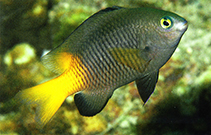| Family: |
Pomacentridae (Damselfishes), subfamily: Microspathodontinae |
| Max. size: |
11 cm TL (male/unsexed) |
| Environment: |
reef-associated; marine; depth range 1 - 10 m, non-migratory |
| Distribution: |
Eastern Indian Ocean: Christmas Island Northwest Pacific: Marcus Island (Minami Tori Shima). These isolated populations are probably relicts of a once widespread species. |
| Diagnosis: |
Dorsal spines (total): 12-12; Dorsal soft rays (total): 15-17; Anal spines: 2-2; Anal soft rays: 11-13. Diagnosis: Scales of head and body finely ctenoid, few cycloid may be present on ventral of head and on snout. Pale blue-gray to charcoal in color with dusky gray scale margins, appearing as series of narrow transverse bands. The posteriormost part of body, caudal peduncle, caudal fin and posterior part of dorsal fin are bright yellow; suborbital bluish and lavender. An elongate black patch with narrow blue margin is between 1st and 4th dorsal spines. The pectoral fins are translucent with a suffusion of yellow. A small black spot is at the base of the uppermost rays of the pectoral fin (Ref. 510). Body depth 1.9-2.1 in SL (Ref. 90102). |
| Biology: |
This occasionally schooling species inhabits shallow rock and coral reefs (Ref. 510). Oviparous, distinct pairing during breeding (Ref. 205). Eggs are demersal and adhere to the substrate (Ref. 205). Males guard and aerate the eggs (Ref. 205). |
| IUCN Red List Status: |
Not Evaluated (N.E.) Ref. (130435)
|
| Threat to humans: |
harmless |
Source and more info: www.fishbase.org. For personal, classroom, and other internal use only. Not for publication.

